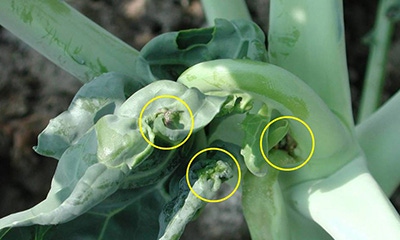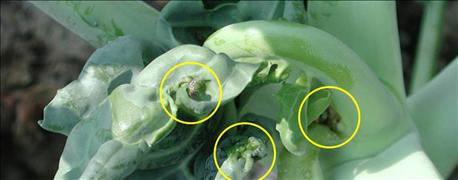March 14, 2016

Last summer, organic vegetable growers in Sanilac County, with help from Michigan State University Extension educator Ben Phillips, discovered a new invasive pest in their fields: the Swede midge. Though this marked the fly’s first appearance in Michigan, the native of Europe and southwestern Asia has been troubling growers in North America for more than 15 years. Despite a short life span and limited flying capability, the Swede midge presents new challenges for growers, particularly those engaged in organic agriculture.

Swede midge presents new challenges for Michigan vegetable growers. web.entomology.cornell.edu
The greatest danger is that its larvae target the very part of the plant the grower is trying to sell. Feeding on brassica crops such as broccoli, cabbage and cauliflower, the fly seeks out areas of new plant growth, where tissue is softer, to lay its eggs. Within five days, the eggs hatch and the new larvae begin feeding on the fresh tissue. This process, known as “blinding,” results in irreparable damage to plant growth, reducing both the crop’s health and marketability. Afflicted plants retain their older, lower leaves but cannot generate the healthy vegetable heads needed for the marketplace. As they feed, the larvae also leave cosmetic damage in the form of feeding scars and expose the plant tissue to rot. Plants may also become distorted, growing in unappealing, irregular shapes in an effort to compensate for the tissue loss.
Though adult female Swede midges live for only one to five days, they can lay up to 100 eggs in that time. Three to five generations of the fly are typical throughout a normal Michigan growing season.
The Swede midge’s long presence in North America has produced research with a great deal of relevance for Michigan. In New York, where the fly has been present since 2004, scientists have developed numerous strategies to mitigate damage. As with any pest, close, consistent scouting of fields is essential in determining whether the fly poses a danger to crops. Pheromone traps that specifically target the fly are commercially available. Another effective means of determining its presence is checking the leaf bases, flower buds and growing points of plants for signs of feeding larvae. Effective chemical controls are in use on many large commercial operations as a regular part of the management plan.
The threat to small organic growers is particularly strong because no effective organic chemical controls exist. There are, however, several non-chemical options. Because of the fly’s short life span and its inability to travel far, growers are encouraged to practice consistent crop rotation. Choosing cultivars with lower susceptibility, such as Triathlon or Regal broccoli, can also reduce damage. So can biocontrols such as lady beetles and nematodes.
Researchers at MSU have applied for a grant through Project GREEEN to study Swede midge distribution in Michigan. The project will establish a statewide network of pheromone traps to determine the magnitude of its presence. By setting traps on farms of varying sizes across the state and checking them throughout the growing season, we will have a better understanding of the fly’s distribution. After that, research will focus on viable means for growers to protect their crops.
Szendrei is a MSU AgBioResearch associate professor in the Department of Entomology. Email her at [email protected].
You May Also Like




